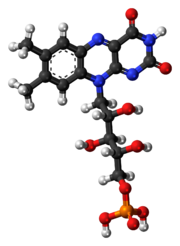Flavin mononucleotide/ja: Difference between revisions
Created page with "フラビンモノヌクレオチド" Tags: Mobile edit Mobile web edit |
Created page with "{{chembox | Verifiedfields = changed | Watchedfields = changed | verifiedrevid = 461100522 | ImageFile = Flavin mononucleotide v2.svg | ImageSize = 180 | ImageAlt = フラビンモノヌクレオチドの骨格式 | ImageFile1 = Flavin mononucleotide 3D ball.png | ImageSize1 = 180 | ImageAlt1 = フラビンモノヌクレオチド分子のボール&スティックモデル | IUPACName = 1-Deoxy-1-(7,8-dimethyl-2,4-dioxo-3,4-dihydrobenzo[''g'']pteridin-10(2''H'')-yl)-<s..." |
||
| Line 1: | Line 1: | ||
<languages /> | <languages /> | ||
{{chembox | {{chembox | ||
| Verifiedfields = changed | | Verifiedfields = changed | ||
| Line 7: | Line 6: | ||
| ImageFile = Flavin mononucleotide v2.svg | | ImageFile = Flavin mononucleotide v2.svg | ||
| ImageSize = 180 | | ImageSize = 180 | ||
| ImageAlt = | | ImageAlt = フラビンモノヌクレオチドの骨格式 | ||
| ImageFile1 = Flavin mononucleotide 3D ball.png | | ImageFile1 = Flavin mononucleotide 3D ball.png | ||
| ImageSize1 = 180 | | ImageSize1 = 180 | ||
| ImageAlt1 = | | ImageAlt1 = フラビンモノヌクレオチド分子のボール&スティックモデル | ||
| IUPACName = 1-Deoxy-1-(7,8-dimethyl-2,4-dioxo-3,4-dihydrobenzo[''g'']pteridin-10(2''H'')-yl)-<small>D</small>-ribitol 5-(dihydrogen phosphate) | | IUPACName = 1-Deoxy-1-(7,8-dimethyl-2,4-dioxo-3,4-dihydrobenzo[''g'']pteridin-10(2''H'')-yl)-<small>D</small>-ribitol 5-(dihydrogen phosphate) | ||
| SystematicName = (2''R'',3''S'',4''S'')-5-(7,8-Dimethyl-2,4-dioxo-3,4-dihydrobenzo[''g'']pteridin-10(2''H'')-yl)-2,3,4-trihydroxypentyl dihydrogen phosphate | | SystematicName = (2''R'',3''S'',4''S'')-5-(7,8-Dimethyl-2,4-dioxo-3,4-dihydrobenzo[''g'']pteridin-10(2''H'')-yl)-2,3,4-trihydroxypentyl dihydrogen phosphate | ||
| Line 51: | Line 50: | ||
}} | }} | ||
}} | }} | ||
''' | '''フラビンモノヌクレオチド'''('''FMN''')、または'''リボフラビン-5′-リン酸'''は、酵素[[riboflavin kinase/ja|リボフラビンキナーゼ]]によって[[riboflavin/ja|リボフラビン]](ビタミンB<sub>2</sub>)から生成される[[biomolecule/ja|生体分子]]であり、[[NADH dehydrogenase/ja|NADHデヒドロゲナーゼ]]を含む様々な[[oxidoreductase/ja|酸化還元酵素]]の[[prosthetic group/ja|補欠基]]として機能する。触媒サイクルの間、酸化型(FMN)、セミキノン型(FMNH<sup>-</sup>)、還元型(FMNH<sub>2</sub>)の可逆的な相互変換が様々な酸化還元酵素で起こる。FMNは[[Nicotinamide adenine dinucleotide/ja|NAD]]よりも強い酸化剤であり、1電子移動と2電子移動の両方に関与できるので特に有用である。青色光受容体としての役割において、(酸化)FMNはE/Z異性化ではなく、シグナル伝達状態として「従来の」光受容体より際立っている。 | ||
<div lang="en" dir="ltr" class="mw-content-ltr"> | <div lang="en" dir="ltr" class="mw-content-ltr"> | ||
Revision as of 15:23, 10 April 2024

| |

| |
| Names | |
|---|---|
| IUPAC name
1-Deoxy-1-(7,8-dimethyl-2,4-dioxo-3,4-dihydrobenzo[g]pteridin-10(2H)-yl)-D-ribitol 5-(dihydrogen phosphate)
| |
| Systematic IUPAC name
(2R,3S,4S)-5-(7,8-Dimethyl-2,4-dioxo-3,4-dihydrobenzo[g]pteridin-10(2H)-yl)-2,3,4-trihydroxypentyl dihydrogen phosphate | |
Other names
| |
| Identifiers | |
3D model (JSmol)
|
|
| ChEBI | |
| ChEMBL | |
| ChemSpider | |
| MeSH | Flavin+mononucleotide |
PubChem CID
|
|
| UNII | |
| |
| |
| Properties | |
| C17H21N4O9P | |
| Molar mass | 456.344 g/mol |
| Melting point | 195 °C |
フラビンモノヌクレオチド(FMN)、またはリボフラビン-5′-リン酸は、酵素リボフラビンキナーゼによってリボフラビン(ビタミンB2)から生成される生体分子であり、NADHデヒドロゲナーゼを含む様々な酸化還元酵素の補欠基として機能する。触媒サイクルの間、酸化型(FMN)、セミキノン型(FMNH-)、還元型(FMNH2)の可逆的な相互変換が様々な酸化還元酵素で起こる。FMNはNADよりも強い酸化剤であり、1電子移動と2電子移動の両方に関与できるので特に有用である。青色光受容体としての役割において、(酸化)FMNはE/Z異性化ではなく、シグナル伝達状態として「従来の」光受容体より際立っている。
It is the principal form in which riboflavin is found in cells and tissues. It requires more energy to produce, but is more soluble than riboflavin. In cells, FMN occurs freely circulating but also in several covalently bound forms. Covalently or non-covalently bound FMN is a cofactor of many enzymes playing an important pathophysiological role in cellular metabolism. For example dissociation of flavin mononucleotide from mitochondrial complex I has been shown to occur during ischemia/reperfusion brain injury during stroke.
Food additive
Flavin mononucleotide is also used as an orange-red food colour additive, designated in Europe as E number E101a.
E106, a very closely related food dye, is riboflavin-5′-phosphate sodium salt, which consists mainly of the monosodium salt of the 5′-monophosphate ester of riboflavin. It is rapidly turned to free riboflavin after ingestion. It is found in many foods for babies and young children as well as jams, milk products, and sweets and sugar products.
See also
External links
| この記事は、クリエイティブ・コモンズ・表示・継承ライセンス3.0のもとで公表されたウィキペディアの項目Flavin mononucleotide/ja(19 March 2024編集記事参照)を素材として二次利用しています。 Lua error in Module:Itemnumber at line 91: attempt to concatenate local 'qid' (a nil value). |